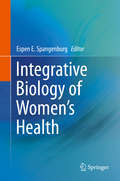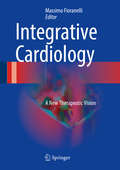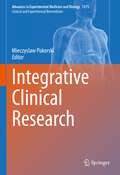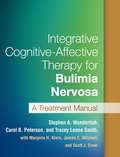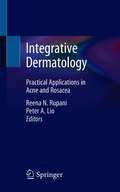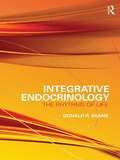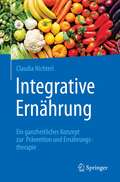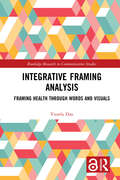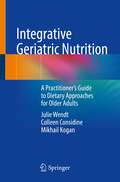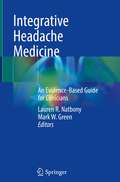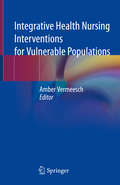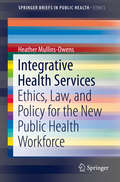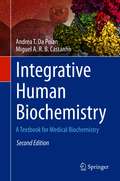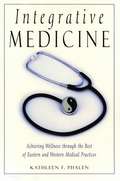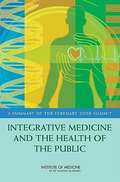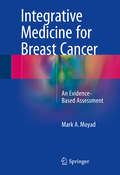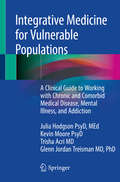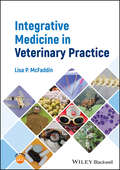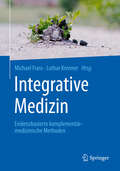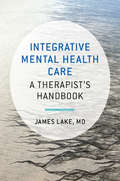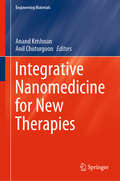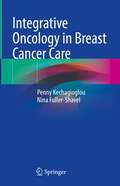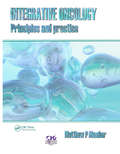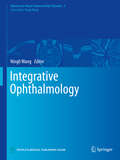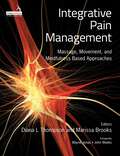- Table View
- List View
Integrative Biology of Women's Health
by Espen E. SpangenburgDefining and understanding cellular and molecular mechanisms that are relevant to women's health has become a critical area of scientific pursuit. Until recently, very little effort has been place on defining or understanding critical differences between women and men that may be critical to the overall health of the woman. In 1990, the National Institutes of Health recognized this gap in knowledge resulting in the creation of the Office of Research on Women's Health. One of the purposes of this office was to advance the understanding of health issues from the women's perspective from both a basic and clinical scientific perspective. From a scientific evolution of understanding, the existence of this office is new and thus there has not been enough time for new information to integrate itself in our current scientific thought process. This book will seek to capture and disseminate our current understanding of scientific advancements relevant to women's health and provide the information to a broad audience. The purpose of this work is to discuss recent advancements in basic science across three areas of concern for women's health. In addition, the book will provide "translational" chapters that attempt to place the basic science work in context within our current understanding of the human. Although it is well acknowledge that gender differences exist across organ function which translates into differences in whole body function, until recently little effort has been made to define basic mechanisms within various tissues within the woman. This work will focus on recent scientific findings that are relevant to women's health and to provide novel and relevant information to interested scientists and clinicians.
Integrative Cardiology
by Massimo FioranelliThis book is a detailed guide to a new integrative approach to the prevention and treatment of various cardiac disorders and risk factors, including coronary artery disease, congestive heart failure, arrhythmias, dyslipidemia, and hypertension. This approach combines various strategies, including metabolic cardiology, low-dose medicine, exercise programs, stress management programs, evaluation for inherited risk factors, and various other healing modalities. Metabolic cardiology focuses on the prevention, management, and treatment of cardiovascular disease at the cellular level through biochemical interventions with nutritional supplements that can promote energy production in the heart. Low-dose medicine, on the other hand, interprets pathological phenomena as an imbalance in intercellular signaling that may be corrected through the administration of low physiological doses of messenger molecules. Therapies outside of mainstream medicine may also be deployed in integrative cardiology, for example acupuncture, herbal medicine, and homeopathy. Integrative Cardiology will be of interest to all practitioners wishing to learn about an approach that incorporates the incredible advances in medication and technology with a focus on nutrition, lifestyle, and mind-body influences.
Integrative Clinical Research (Advances in Experimental Medicine and Biology #1375)
by Mieczyslaw PokorskiThis book embraces a comprehensive range of research across several disciplines, providing insights and fresh perspectives on clinical topics, emphasizing the integrative medical approach. The book also addresses an increasing role of artificial intelligence in the development of clinical methodologies, research, and patient-oriented care. The authors share expertise and experience in rehabilitation medicine whose healing-effects particularly depend on the interaction between the therapist and patient. Chapters present novel approaches in manual rehabilitative therapy of common painful and disabling neuromuscular ailments, exemplified but not limited to low back pain and migraine. The myofascial trigger point release therapy includes specific manipulations to muscles and connective tissue which reduce pain. Other chapters address the issues of providing long-range medical care to older adults burdened with chronic diseases, notably hypoxia-related pathologies and their sequalae, pointing to the advantages of care provided by a single primary care physician. Changing paradigm of care is essential in chronic atherosclerosis-based diseases like cardiovascular disorders or diabetes. Chapters provide results of international cohort studies on predictive factors for the long-range progress of such ailments based on anthropometric and lifestyle indicators. The book aims to meet the increasing interest and importance to patients of integrative health therapies. Medical rehabilitation and lifestyle changes increasingly gain scientific support in difficult-to-treat chronic conditions and should be integrated in a controlled manner into conventional medicine. The book is addressed to physiotherapists, medical scientists and clinicians, and allied healthcare professionals.
Integrative Cognitive-Affective Therapy for Bulimia Nervosa
by PhD Carol B. Peterson James E. Mitchell Tracey Leone Smith Scott J. Crow Stephen A. Wonderlich Marjorie H. KleinPacked with useful clinical tools, this state-of-the-art manual presents an empirically supported treatment solidly grounded in current scientific knowledge. Integrative cognitive-affective therapy for bulimia nervosa (ICAT-BN) has a unique emphasis on emotion. Interventions focus on helping clients understand the links between emotional states and BN as they work to improve their eating behaviors, defuse the triggers of bulimic episodes, and build crucial emotion regulation skills. In a large-size format for easy photocopying, the book includes 47 reproducible handouts. Purchasers get access to a Web page where they can download and print the reproducible materials.
Integrative Dermatology: Practical Applications in Acne and Rosacea (Integrative Medicine Library)
by Peter A. Lio Reena N. RupaniThis book offers the most up-to-date and evidence-based information surrounding integrative treatments for acne and rosacea. Ranging from topical solutions, to nutrition, to mind-body medicine, each chapter addresses evidence for use and patient outcomes. Discussions regarding oral and topical botanical supplements and dietary modifications are complemented by the examination of non-Western healing systems' approach to acne and rosacea. Backed by clinical evidence, chapters feature real patient outcomes with complete explanations of the viability of the treatment. Concise and unique, Integrative Dermatology: Practical Applications in Acne and Rosacea, is an invaluable text for not only the dermatologist, but the pediatrician, family practitioner, internist, and holistic/alternative provider.
Integrative Endocrinology: The Rhythms of Life
by Donald R BeansThis book explains the treatment of endocrine disorders using natural therapies. Donald Beans provides the reader with everything there is to know to treat endocrine disorders without hormones. This book outlines the function of the endocrine glands and the testing of their function including clinical laboratory evaluation and bedside diagnosis. This is the first book to include the entire endocrine system and many natural therapies in one text, thus allowing the practitioner an unprecedented insight into endocrine treatment. Integrative Endocrinology discusses, in depth, the fundamental philosophical difference between hormone replacement therapy and integrative endocrinology. Natural therapies include acupuncture, gland cell therapy, homeopathy, herbal medicine, and a number of other methods. This book is of great value to health professionals, students and scholars in integrative medicine, alternative medicine and endocrinology. It is also valuable as a self help handbook for the motivated non-professional.
Integrative Ernährung: Ein ganzheitliches Konzept zur Prävention und Ernährungstherapie
by Claudia NichterlIntegrative Ernährung kombiniert die Ernährungswissenschaft mit traditionellen medizinischen Systemen. Sie bietet ein seriöses Fundament für individuelle Ernährungsempfehlungen, die praxisnah und nachhaltig sind. Das Buch stellt die integrative Ernährungstherapie als ganzheitliches Konzept für die Prävention und Gesunderhaltung, aber auch als komplementäre Unterstützung zur Behandlung von Zivilisationskrankheiten, wie etwa Übergewicht, Allergien und/oder Unverträglichkeiten, Reizdarm, chronisch entzündlichen Darmerkrankungen, Autoimmunerkrankungen vor. Der erste Teil behandelt die Grundlagen und die wesentlichen Prinzipien der Traditionellen Chinesischen Medizin (TCM) im Vergleich zur klassischen Ernährungswissenschaft und Ernährungsmedizin. Im zweiten Teil werden die Vorteile der Integrativen Ernährung anhand von häufigen Beschwerde- und Krankheitsbildern beleuchtet. Im dritten und letzten Teil wird ein Ausblick auf die Einsatzmöglichkeiten gegeben. Das Buch richtet sich an Ärzte und Therapeuten, wie sie mit punktgenauen Tipps und Maßnahmen den Therapieerfolg ihrer Patienten unterstützen können, darüber hinaus schätzen auch Konsumenten die Hinweise zur Selbsthilfe.
Integrative Framing Analysis: Framing Health through Words and Visuals (Routledge Research in Communication Studies)
by Viorela DanMuch of framing scholarship focuses either exclusively on the analysis of words or of visuals. This book aims to address this gap by proposing a six-step approach to the analysis of verbal frames, visual frames and the interplay between them—an integrative framing analysis. This approach is then demonstrated through a study investigating the way words and visuals are used to frame people living with HIV/AIDS in various communication contexts: the news, public service announcements and special interest publications. This application of integrative framing analysis reveals differences between verbal frames and visual frames in the same messages, underscoring the importance of looking at these frames together.
Integrative Geriatric Nutrition: A Practitioner’s Guide to Dietary Approaches for Older Adults
by Mikhail Kogan Julie Wendt Colleen ConsidineThis book provides a review of therapeutic foods and diets for aging patients. Drawing from extensive clinical experience in large integrative medical practices, it offers a unique and thorough perspective on the challenges that older adults present and the most effective ways to integrate nutritional approaches into their care. Nutritional therapies included here improve patient quality of life via noninvasive, lower cost care and reduce systemic dependencies in a growing demographic. This book looks at condition-specific interventions to equip the practitioner with a thorough understanding of when to call upon specific diet interventions. The text revolves around easily translated clinical tools such as tables, graphs, case studies, and examples to assure multicultural adaptation of evidence-based approaches for conventional use in clinical settings. Integrative Geriatric Nutrition: A Practitioner’s Guide to Dietary Approaches for Older Adults is a concise yet thorough resource for all physicians and medical students who treat aging patients, including geriatricians, nutritionists, family physicians, gastroenterologists, nursing home administrators, nurses, other healthcare providers, geriatric advocates, and inquisitive consumers.
Integrative Headache Medicine: An Evidence-Based Guide for Clinicians
by Mark W. Green Lauren R. NatbonyThis practical and comprehensive title provides illuminating, evidence-based approaches in headache medicine for using traditional medical therapies in conjunction with alternative approaches to care. In all, the book details how multidisciplinary management and the combination of conventional and complementary medical services – integrative medicine – leads to superior patient outcomes: improved patient satisfaction, reduced stress, and more readily treatable, less serious illness. State-of-the-art and developed by experts in their fields, these 12 chapters present research and analysis of a wide range of non-pharmacologic interventions in headache care, seeking to inspire clinicians to formulate personalized headache treatment plans, and to work together by integrating their expertise in a multidisciplinary context to address patients’ unique conditions, needs, circumstances, and treatment.Chapter one provides an overview of integrative medicine and proposes a step-wise approach for incorporating integrative modalities into a headache practice. Chapter two focuses on the attention to be paid to relevant aspects of a patient’s medical history. The next four chapters discuss lifestyle factors that play a role in headache, including trigger identification, exercise, nutrition, and sleep. The scope of mind-body therapies such as acupuncture, yoga, and mindfulness is explored in chapter seven, and the psychology of pain is the subject of chapter eight. Chapter nine investigates the safety and efficacy of nutraceuticals, or pharmaceutical alternatives. The final three chapters review neuromodulation and interventional approaches to headache management. An invaluable and timely contribution to the clinical literature, Integrative Headache Medicine – An Evidence-Based Guide for Clinicians will be of great interest to neurologists, pain physicians, primary care clinicians, behavioral psychologists, psychiatrists, physical therapists, social workers, nutritionists and any other health professionals interested in delivering the highest quality care for headache patients.
Integrative Health Nursing Interventions for Vulnerable Populations
by Amber VermeeschThis book provides nurses, clinicians, practitioners, educators and students working with vulnerable and underserved populations with essential information on effective wellness strategies to address inadequate nutrition, promote physical activity, and reduce perceived stress through an integrative health nursing framework.It begins with an overview of cultural humility, health inequities, and social justice, establishing the need for an integrative health nursing framework. In turn, the book addresses a broad range of interventions; particular attention is given to wellness strategies designed to prevent the adverse effects of poor nutrition, perceived stress, and lack of physical activity. Written by respected experts in the field, the book offers readers valuable insights into strategies for working with vulnerable populations. Accordingly, it will appeal to researchers working to diminish health inequities among vulnerable populations, and will be of particular interest to nursing educators, practitioners, and students.
Integrative Health Services
by Heather Mullins-OwensThis readable overview offers a public health framework for integrating medical and alternative care to improve health outcomes in patients with chronic illnesses. It details the promise, potential, and challenges of holistic services as patients seek diverse treatment options and health care systems address the demand for more affordable, accessible, and effective care. The book's integrative model describes the process in theory and practice, from cost and reimbursement issues and turf wars between providers to expanding on traditional concepts of illness and wellness. Learning objectives, case studies, discussion questions, and other helpful features make this a vital student text. The book's concentrated coverage: Introduces concepts of integrative health services. Applies integrative health concepts to public health areas, e. g. , prevention. Contrasts integrative models of health with the traditional biomedical model. Outlines the scope of integrative health practice. Reviews implications for the public health workforce. Integrative Health Services benefits public health students, pre-med students, and those with an interest in health policy and health trends. Additionally, public health educators, practitioners, and scholars who may not be familiar with integrative health services and conflicts related to their increased use in health care will find it a helpful tool to quickly bring them up to date
Integrative Human Biochemistry: A Textbook for Medical Biochemistry
by Miguel A. Castanho Andrea T. Da PoianThis book covers in detail the mechanisms for how energy is managed in the human body. The basic principles that elucidate the reactivity and physical interactions of matter are addressed and quantified with simple approaches. Three-dimensional representations of molecules are presented throughout the book so molecules can be viewed as unique entities in their shape and function. The book is focused on the molecular mechanisms of cellular processes in the context of human physiological situations such as fasting, feeding and physical exercise, in which metabolic regulation is highlighted. Furthermore the book uses key historical experiments that opened up new concepts in biochemistry to further illustrate how the human body functions at molecular level, helping students to appreciate how scientific knowledge emerges.New to this edition:- 30 challenging practical case studies (2-3 at the end of each chapter) based on movies, novels, biographies, documentaries, paintings, and other cultural and artistic creations far beyond canonic academic exercises.- A set of challenging questions and problems in the end of each case study to further engage students with the applications of medical biochemistry- Insights into the answers to the challenging questions to help steer teaching/learning interactions key to productive lectures, PBL (problem-based learning) or traditional tutorials, or e-learning approaches.Advance praise for the second edition:“The Challenging Cases are compelling both from a scientific viewpoint and for the perspective they provide on the history of medicine.” David M. Jameson, University of Hawaii “Using case studies to reinforce the biochemistry lessons is extremely effective – as well as entertaining!” Joseph P. Albanesi, UT Southwestern Medical CenterAdvance Praise for the first edition:“This textbook provides a modern and integrative perspective of human biochemistry and will be a faithful companion to health science students following curricula in which this discipline is addressed. This textbook will be a most useful tool for the teaching community.”Joan Guinovart Former director of the Institute for Research in Biomedicine, Barcelona, Spain, and former president of the International Union of Biochemistry and Molecular Biology, IUBMB
Integrative Medicine
by Kathleen F. PhalenKathleen Phelan brings her skills as an investigative reporter and her experience as a medical writer to bear in a tour de force-part history. part story. part resource- for any reader seriously interested in his or her own well-being and in the future of medicine and medical treatment in this country Once considered "alternative; Eastern medicine has gained widespread acceptance by the general public, but it is the blending (or integration) of Eastern healing with Western medicine that is now commanding the attention of the medical community.Dating the birth of integrative medicine to 1971, when James Reston brought the concept of acupuncture and Chinese herbs to America's shores, Phelan traces a movement that's grown into a $15 billion dollar industry in a generation .Through interviews with Eastern and Western practitioners and their clients, she puts a human face on the "crisis" of medical care in our time . Withextensive detail, she recounts the history of both Eastern and Western medicine, presenting the best-and sometimes exposing the myths-of both ancient cures and current high-tech methods.
Integrative Medicine and the Health of the Public: A Summary of the February 2009 Summit
by Institute of MedicineThe last century witnessed dramatic changes in the practice of health care, and coming decades promise advances that were not imaginable even in the relatively recent past. Science and technology continue to offer new insights into disease pathways and treatments, as well as mechanisms of protecting health and preventing disease. Genomics and proteomics are bringing personalized risk assessment, prevention, and treatment options within reach; health information technology is expediting the collection and analysis of large amounts of data that can lead to improved care; and many disciplines are contributing to a broadening understanding of the complex interplay among biology, environment, behavior, and socioeconomic factors that shape health and wellness. On February 25 - 27, 2009, the Institute of Medicine (IOM) convened the Summit on Integrative Medicine and the Health of the Public in Washington, DC. The summit brought together more than 600 scientists, academic leaders, policy experts, health practitioners, advocates, and other participants from many disciplines to examine the practice of integrative medicine, its scientific basis, and its potential for improving health. This publication summarizes the background, presentations, and discussions that occurred during the summit.
Integrative Medicine for Breast Cancer
by Mark A. MoyadThis book is designed to capture and clinically review the comprehensive database of clinical research articles that support and do not support the utilization of a variety of dietary supplements and other complementary medicines that physicians are exposed to in their daily practice. The growing list of CAM products that could interfere with surgery (anesthesia, bleeding, outcomes. . . ) and/or conventional medicines is very large and is provided in each section of the book. Additionally, the list of dietary supplements that could be utilized to improve quality of life for breast cancer patients is also emphasized. The various sub-specialty groups in breast are adequately represented, which allows for a physician to rapidly and thoroughly investigate their topic of interest regardless of whether the topic is prevention, treatment, or a specific side effect of treatment. The practical nature of Integrative Medicine for Breast Cancer: An Evidence-Based Assessment cannot be overstated. Chapters include a general overview of the CAM agent, whether or not it has data in medicine and oncology, and a list of potential drug interactions and specific clinical scenarios where it can be utilized or discouraged in the specialty. Thus, this book will become the gold standard evidence based text for use in teaching, not only for the students interested in oncology and breast cancer, but for all current oncology health providers.
Integrative Medicine for Vulnerable Populations: A Clinical Guide to Working with Chronic and Comorbid Medical Disease, Mental Illness, and Addiction
by Kevin Moore Julia Hodgson Trisha Acri Glenn Jordan TreismanThis first-of-its-kind title addresses the failures of an often fragmented healthcare system in managing vulnerable patients with multiple, chronic, co-morbid conditions -- patients who are frequently unresponsive to the methods and approaches used to treat other patients with conditions that are less complicated. The book emphasizes a holistic evaluation to patient care that looks at the whole patient, providing comprehensive formulations that describe the interacting problems that afflict the patient, including elements that are barriers to effective treatment of active medical problems and barriers to recovery. The book begins by defining integrated care, discussing the types of patients who benefit from this approach and some of the models of care, including financing, barriers to acceptance, and advocacy for patients. The second section discusses the structural elements of integrated care, including the building of a team approach, issues of leadership, and role definition, as well as the authors’ experiences in overcoming some of the problems. In the remaining sections, the book discusses major complicating features of the patients seen in integrative care settings, including a description of the kinds of problems, a model for formulation of patient cases, and successful approaches to treatment of these problems. Finally, some of the real-world applications where integrative care provides better outcomes is covered, including in terms of addictions, medically complex patients, and chronic pain patients. Integrative Medicine for Vulnerable Populations - A Clinical Guide to Working with Chronic and Comorbid Medical Disease, Mental Illness, and Addiction is a major contribution to the clinical literature and will be of great interest to health care professionals, administrators, policy stakeholders, and even interested patients and patient advocates.
Integrative Medicine in Veterinary Practice
by Lisa P. McFaddinIntegrative Medicine in Veterinary Practice Enables the entire veterinary team to seamlessly incorporate integrative medicine into everyday practice Integrative Medicine in Veterinary Practice is a unique resource designed to introduce the basic concepts of ten different integrative modalities to all members of the hospital team to establish a baseline of knowledge: explaining how patients will benefit from their use, discussing return on investment, informing veterinarians of available courses and suggested reading materials, walking managers through staff training, and providing client education materials. Supplemental web-based documents and presentations increase the ease with which staff are trained and clients are educated. Integrative medicine is not an all-or-nothing concept. This umbrella term encompasses a wide spectrum of treatment modalities. Therapies can be used individually or in combination, as part of a multimodal approach, and applied easily to every patient or used in select cases. Sample topics covered in Integrative Medicine in Veterinary Practice include: Photobiomodulation, covering light, laser specifics, mechanisms of action, supplies and equipment, and techniques Veterinary Spinal Manipulation Therapy (VSMT), covering pain in veterinary patients, mechanisms of action, adjustment vs. manipulation vs. mobilization, techniques, and post-adjustment recommendations Acupuncture, covering acupuncture point selection using traditional Chinese veterinary medicine (TCVM) and Western medicine techniques, mechanisms of action, safety, and practical applications. Chinese Herbal Medicine (CHM), covering TCVM fundamentals as it applies to herbal classification and selection, herb production, safety, and formulation, and CHM applications. Integrative Medicine in Veterinary Practice is a valuable resource for all veterinary hospital team members, from customer service representatives to veterinary assistants/technicians, practice managers, and veterinarians. The text is also helpful to veterinary students interested in integrative medicine, or those taking introductory integrative medicine courses.
Integrative Medizin: Evidenzbasierte komplementärmedizinische Methoden
by Karin DembowskyIntegration ist in der Gesellschaft zu einem Schlüsselbegriff geworden – auch in der Medizin. Die ganzheitliche Anwendung unterschiedlicher medizinischer Konzepte kann zu einer Steigerung der Therapieeffekte und zu einer Reduktion der Kosten im Gesundheitswesen führen.Das Buch bietet einen umfassenden Überblick über die vielfältigen Methoden innerhalb der Komplementärmedizin sowie die entsprechenden diagnostischen und therapeutischen Ansätze. Eine Besonderheit dieses Buches ist die Darstellung der jeweiligen evidenzbasierten Studienlage, die sich insgesamt deutlich verbessert hat und die Möglichkeiten der Integration in das bestehende westliche Medizinsystem untermauert. Berücksichtigt werden ferner die naturwissenschaftlichen Grundlagen, rechtlich-ethische Aspekte der Ganzheitsmedizin und der Stand der europäischen Forschungsbemühungen.Dieses Kompendium soll somit dazu dienen, die Grundlagen für eine Ergänzung des gegenwärtigen konventionellen medizinischen Alltags zu schaffen. Es soll das große Potenzial und den Umfang der Medizinkunst aufzeigen und dazu beitragen, die Ganzheitlichkeit der Medizin wiederherzustellen und das umfangreiche Wissen der klinischen Erfahrungsheilkunde gleichrangig in die westliche Medizin zu integrieren.
Integrative Mental Health Care: A Therapist's Handbook
by James LakeMaking sense of complementary and alternative treatments in mental health care. In mental health care, as in medical care, more and more clinicians are turning to unconventional assessment and treatment approaches to evaluate and treat their patients in the most effective way possible. But how is a clinician to makes sense of the range of complementary and alternative treatments (CAM), and when is it appropriate and safe to use conventional therapies alongside them? In this practical resource, Dr. Lake, a pioneer in the field of integrative mental healthcare, teaches readers how to integrate conventional mental healthcare--drugs and psychotherapy--with complementary and alternative approaches, including vitamins, minerals, amino acids, essential fatty acids and other natural products, mind-body practices, light therapy, music, biofeedback, energy therapies, acupuncture, and others. This is a concise, evidence-based guide to the day-to-day management of common mental health problems using an integrative approach.
Integrative Nanomedicine for New Therapies (Engineering Materials)
by Anil Chuturgoon Anand KrishnanThis book presents current laboratory, scientific and clinical aspects of nanomaterials used for medical applications in the fields of regenerative medicine, dentistry and pharmacy. It gives a broad overview of the in vitro compatibility assessment of nanostructured materials implemented in the medical field by the combination of classical biological protocols. The chapters cover all aspects of integrative medicine, such as green derived nanomaterials for biological applications; synthetic and nature-derived lipid nanoparticles and polymer nanoparticles.
Integrative Oncology in Breast Cancer Care
by Penny Kechagioglou Nina Fuller-ShavelIntegrative Oncology (IO) is an evolving evidence-informed field of medicine with little high-quality professional literature currently available to support clinical practice. This book provides a robust introduction to integrative oncology and a practical toolkit for clinicians working with breast cancer patients. Breast cancer is the commonest cancer in women globally with growing incidence, and breast cancer patients are the most frequent users of integrative oncology practices. This book addresses the whole person journey from prevention, to diagnosis, treatment and survivorship. The approaches and tools discussed can help guide clinicians on how to support better quality of life, improve patient resilience, minimise the side effects of treatment and optimise clinical outcomes for people impacted by breast cancer. Healthcare professionals are asking for further education on Integrative Oncology, as evidenced by the BSIO (British Society for Integrative Oncology) survey results, webinars and conference engagements. Our growing BSIO membership highlights the need to educate and train healthcare professionals, and this book is written by clinicians for clinicians.
Integrative Oncology: Principles and Practice
by Matthew P. MumberIntegrative Oncology explores a comprehensive, evidence-based approach to cancer care that addresses all individuals involved in the process, and can include the use of complementary and alternative medicine (CAM) therapies alongside conventional modalities such as chemotherapy, surgery, and radiation therapy. The number of integrative care program
Integrative Ophthalmology (Advances in Visual Science and Eye Diseases #3)
by Ningli WangWith the development of nature science and industrial technology, more and more patients are benefitting from the rapid progress in ophthalmology, as the use of new medicine and delicate surgical therapy has ensured them the chance to restore their sight. However, some problems have come up during its development, of which the most serious one is the limitation of the ophthalmology. Eyes are not isolated organs, they are connected to our body, and thus, the general status of our body will affect the eyes’ function. Therefore, it is of great importance that the ophthalmologists see the big picture while dealing with the clinical problems. Based on the above observations, we put forward the concept of Integrative Ophthalmology, and describe the ophthalmology related medical situations that are prone to be neglected in clinical practice in a bid to increase the awareness of doctors from all fields that a holistic view should be adopted in clinical practice, and it is the patients that we are treating rather than the disease. There are 9 parts in the book, containing the concept of integrative ophthalmology, intraocular and intracranial pressure gradient related diseases,and the relationship between the different general status and eye disorders. We do believe that the integrative ophthalmology is the key to the development of ophthalmology and hope readers can benefit from this book.
Integrative Pain Management
by Diana L. Thompson Marissa BrooksThis book provides an overview of pain mechanisms as currently understood, and details a variety of approaches to pain management used across a wide range of complementary disciplines. A final chapter integrates these body-based and mind-body approaches, and helps the clinician offer the most effective care for the patient.The first part of the book discusses pain symptoms and the ways in which pain is experienced by individual patients. This section deals with the anatomy and pathology of pain, and describes present views of what causes pain to occur and persist. Integrative care concepts are presented, emphasizing multi-disciplinary approaches to addressing pain.In the second part, expert contributors describe therapeutic approaches to addressing pain conditions and implementing self-care management options, specific to the various disciplines. When available, research supporting the evidence for these interventions is incorporated.In the last chapter, the editors model various care pathways based on these approaches to assist healthcare practitioners in deciding how to effectively co-manage pain, including guidance on when and where to refer.
